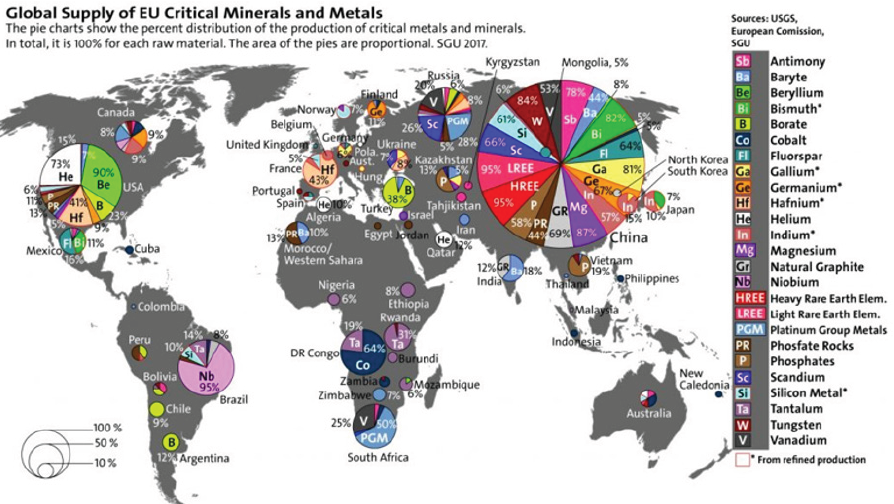- Submissions

Full Text
Aspects in Mining & Mineral Science
A View on Integrated and Sustainable Minerals Value Chains
Nikolaos Arvanitidis*
Economic Geologist, Geological Survey of Sweden, Sweden`
*Corresponding author: Nikolaos Arvanitidis, Economic Geologist, Geological Survey of Sweden, Sweden
Submission: June 24, 2020;Published: August 11, 2020

ISSN 2578-0255Volume5 Issue2
Opinion
Geology defines the occurrence of mineral deposits, and, therefore, mining is geographically constrained. However, the use of the mineral products in down-stream industries often takes place in countries different from the location of the mine. Therefore, mining communities do not necessarily appreciate the importance of mineral production for the benefit of people living in other countries, particularly if there is no tangible sharing of those benefits. Mining cannot choose locations that are logistically, socially, environmentally, or politically appropriate or ‘friendly’. This means that mining companies may have to deal with circumstances that could pose challenges such as the relationship with local communities, position in the landscape/environment, relationship with local and national governments, weak governance and associated increased risk of corruption and bribery. In order to deal with these challenges in a responsible way it means that geoscientists and engineers will need to build their capacity and skills on how to deal with local communities and related social issues. The outcome should be the equitable distribution of the benefits of development, including also mineral land-use planning issues, and minimization of the negative impacts on people and the environment. Thus, a sustainable and integrated view on minerals value chains requires looking even further upstream into the pre-exploration that includes planning process for mineral land use and development at the earliest stage.
Currently, worldwide demand for mineral raw materials is growing due to the emerging digital revolution, the innovation to e-mobility and artificial intelligence technologies, and the transition towards a low-carbon and zero-waste future. Consequently, the intensity on the economy and society, in securing the increasing mineral raw materials supply, will continue remaining notably high, particularly in the case of critical raw materials which by almost 60% are related to high-growth enterprising. This trend is triggering and enabling altered or new value chains of mineral raw materials industries from the upstream to the downstream, e.g. from exploration, mining, processing and products along the value chain to end-use manufacturing. In particular, the new EU Industrial Strategy highlights the importance to maintain full operational capacity of strategic industrial value chains, such as the ones addressing renewable energy, grids, lithium batteries, electric vehicles, robotics and defense applications. In this regard, however, a more holistic view on mineral development and, respectively, integrated minerals value chains also need to look further upstream into the pre-exploration stage to guarantee and secure sustainable supply. To achieve this access to land for extractive activities, responsible and innovative land stewardship throughout the mining life cycle are fundamental. Thus, in order to effectively connect the pre-exploration stage in a holistic and integrated view on sustainable mineral value chains, certain challenges need to be addressed:
a. Comprehensive data and assessment of mineral resources, current and potential land use available for public decision-making in the land use planning process
b. Mechanisms for a transparent and equitable assessment of minerals resource development next to other land use options
c. Higher integration of minerals and land use planning policy resorts on a strategic level to connect two distinct but overlapping policy resorts
d. Mineral and land use planning processes and instruments taking into consideration the safeguarding of mineral resource deposits
If accounted for the abovementioned challenges holistic and integrated sustainable mineral value chains integrate and maximize the multiple benefits related to economic, social, environmental and cultural values. Consequently, the identification of possible synergies or conflicts at an early stage enhances the steering capacity for the preparation and implementation of sustainable land-use plans that include minerals development. Taking the example of a holistic and integrated Lithium Battery value chain it is equally important that land-use planning takes into consideration both the construction of battery-manufacturing plants as well as the upstream mineral resources supply. The integrated value chain approach applies to all land use designations that could alter access to mineral resources. Nature protection areas indicate a particularly important land use designation since they cover almost 18% of land in the EU and still offer possibility for mineral extraction under certain conditions. In particular, for Natura 2000 regulated areas it is important to consider that mineral extraction invariably has an impact on the land. Therefore, a sustainable approach requires addressing the whole mining value chain until the end of the mining life cycle including rehabilitation efforts.
Taking a European or global perspective, however, differing EU MS mining legislation and permit procedures, land use planning processes, health and safety, and environmental protection rules are potentially a barrier to mining activities (Figure 1). Consequently, this may cause vulnerabilities in an integrated mineral value chain. Therefore, effective land-use planning for mineral resources in the pre-exploration stage requires the use of mineral resource maps and assessment methods, safeguarding mechanisms for mineral deposits, and integrated mineral and land use planning policy.
Figure 1: Global supply of EU critical minerals and metals.

© 2020 Nikolaos Arvanitidis. This is an open access article distributed under the terms of the Creative Commons Attribution License , which permits unrestricted use, distribution, and build upon your work non-commercially.
 a Creative Commons Attribution 4.0 International License. Based on a work at www.crimsonpublishers.com.
Best viewed in
a Creative Commons Attribution 4.0 International License. Based on a work at www.crimsonpublishers.com.
Best viewed in 







.jpg)






























 Editorial Board Registrations
Editorial Board Registrations Submit your Article
Submit your Article Refer a Friend
Refer a Friend Advertise With Us
Advertise With Us
.jpg)






.jpg)














.bmp)
.jpg)
.png)
.jpg)










.jpg)






.png)

.png)



.png)






